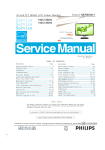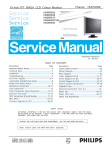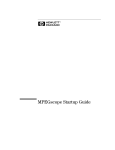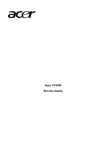Download Acer V223W Technical information
Transcript
Acer V223W Service Guide 1 Service Guide Version and Revision Version A00 Release Date Revision History TPV model Initial Release TC7ANCD8W7AYHN Mar.-17-2008 2 Copyright Copyright © 2003 by Acer Incorporated. All rights reserved. No part of this publication may be reproduced, Transmitted, transcribed, stored in a retrieval system, or translated into any language or computer language, in any form or by any means, electronic, mechanical, magnetic, optical, chemical, manual or otherwise, without the prior written permission of Acer Incorporated. Disclaimer The information in this guide is subject to change without notice. Acer Incorporated makes no representations or warranties, either expressed or implied, with respect to the contents hereof and specifically disclaims any warranties of merchantability or fitness for any particular purpose. Any Acer Incorporated software described in this manual is sold or licensed "as is". Should the programs prove defective following their purchase, the buyer (and not Acer Incorporated, its distributor, or its dealer) assumes the entire cost of all necessary servicing, repair, and any incidental or consequential damages resulting from any defect in the software. Intel is a registered trademark of Intel Corporation. Pentium and Pentium II/III are trademarks of Intel Corporation. Other brand and product names are trademarks and/or registered trademarks of their respective holders. Trademarks Acer is a registered trademark of Acer Incorporated. All other trademarks are property of their respective owners. Conventions The following conventions are used in this manual: Screen messages Denotes actual messages that appear on screen. Note Gives bits and pieces of additional information related to the current topic. Warning Alerts you to any damage that might result from doing or not doing specific actions. Caution Gives precautionary measures to avoid possible hardware or software problems. Important Remind you to do specific actions relevant to the accomplishment of procedures. 3 Preface Before using this information and the product it supports, please read the following general information. 1. This Service Guide provides you with all technical information relating to the BASIC CONFIGURATION decided for Acer's "global" product offering. To better fit local market requirements and enhance product competitiveness, your regional office may have decided to extend the functionality of a machine (e.g. add-on card, modem, or extra memory capability). These LOCALIZED FEATURES will NOT be covered in this generic service guide. In such cases, please contact your regional offices or the responsible personnel/channel to provide you with further technical details. 2. Please note WHEN ORDERING FRU PARTS, that you should check the most up-to-date information available on your regional web or channel. If, for whatever reason, a part number change is made, it will not be noted in the printed Service Guide. For ACER-AUTHORIZED SERVICE PROVIDERS, your Acer office may have a DIFFERENT part number code to those given in the FRU list of this printed Service Guide. You MUST use the list provided by your regional Acer office to order FRU parts for repair and service of customer machines. Warning: (For FCC Certified Models) Note: This equipment has been tested and found to comply with the limits for a Class B digital device, pursuant to Part 15 of the FCC Rules. These limits are designed to provide reasonable protection against harmful interference in a residential installation. This equipment generates, uses and can radiate radio frequency energy, and if not installed and used in accordance with the instructions, may cause harmful interference to radio communications. However, there is no guarantee that interference will not occur in a particular installation. If this equipment does cause harmful interference to radio or television reception, which can be determined by turning the equipment off and on, the user is encouraged to try to correct the interference by one or more of the following measures: 1. Reorient or relocate the receiving antenna. 2. Increase the separation between the equipment and receiver. 3. Connect the equipment into an outlet on a circuit different from that to which the receiver is connected. 4. Consult the dealer or an experienced radio/TV technician for help. Notice: 1. The changes or modifications not expressly approved by the party responsible for compliance could void the user's authority to operate the equipment. 2. Shielded interface cables and AC power cord, if any, must be used in order to comply with the emission limits. 3. The manufacturer is not responsible for any radio or TV interference caused by unauthorized modification to this equipment. It is the As ENERGY STAR responsibility of the user to correct such interference. Partner our company has determined that this product meets the ENERGY STAR guidelines for energy efficiency. Warning: To prevent fire or shock hazard, do not expose the monitor to rain or moisture. Dangerous high voltages are present inside the monitor. Do not open the cabinet. Refer servicing to qualified personnel only. 4 Precautions Do not use the monitor near water, e.g. near a bathtub, washbowl, kitchen sink, laundry tub, swimming pool or in a wet basement. Do not place the monitor on an unstable trolley, stand, or table. If the monitor falls, it can injure a person and cause serious damage to the appliance. Use only a trolley or stand recommended by the manufacturer or sold with the monitor. If you mount the monitor on a wall or shelf, uses a mounting kit approved by the manufacturer and follow the kit instructions. Slots and openings in the back and bottom of the cabinet are provided for ventilation. To ensure reliable operation of the monitor and to protect it from overheating, be sure these openings are not blocked or covered. Do not place the monitor on a bed, sofa, rug, or similar surface. Do not place the monitor near or over a radiator or heat register. Do not place the monitor in a bookcase or cabinet unless proper ventilation is provided. The monitor should be operated only from the type of power source indicated on the label. If you are not sure of the type of power supplied to your home, consult your dealer or local power company. The monitor is equipped with a three-pronged grounded plug, a plug with a third (grounding) pin. This plug will fit only into a grounded power outlet as a safety feature. If your outlet does not accommodate the three-wire plug, have an electrician install the correct outlet, or use an adapter to ground the appliance safely. Do not defeat the safety purpose of the grounded plug. Unplug the unit during a lightning storm or when it will not be used for long periods of time. This will protect the monitor from damage due to power surges. Do not overload power strips and extension cords. Overloading can result in fire or electric shock. Never push any object into the slot on the monitor cabinet. It could short circuit parts causing a fire or electric shock. Never spill liquids on the monitor. Do not attempt to service the monitor yourself; opening or removing covers can expose you to dangerous voltages and other hazards. Please refer all servicing to qualified service personnel To ensure satisfactory operation, use the monitor only with UL listed computers which have appropriate configured receptacles marked between 100 - 240V AC, Min. 5A. The wall socket shall be installed near the equipment and shall be easily accessible. Special Notes On LCD Monitors The following symptoms are normal with LCD monitor and do not indicate a problem. Notes Due to the nature of the fluorescent light, the screen may flicker during initial use. Turn off the Power Switch and then turn it on again to make sure the flicker disappears. You may find slightly uneven brightness on the screen depending on the desktop pattern you use. The LCD screen has effective pixels of 99.99% or more. It may include blemishes of 0.01% or less such as a missing pixel or a pixel lit all of the time. Due to the nature of the LCD screen, an afterimage of the previous screen may remain after switching the image, when the same image is displayed for hours. In this case, the screen is recovered slowly by changing the image or turning off the Power Switch for hours. 5 Table Of Contents Chapter 1 Monitor Features ………………………………………… 7 Introduction ……………………………………… 7 Electrical Requirements ……………………………………… 8 LCD Monitor General Specification ……………………………………… 9 LCD Panel Specification ……………………………………… 10 Support Timing ……………………………………… 13 Monitor Block Diagram ……………………………………… 14 Main Board Diagram ……………………………………… 15 Software Flow chart ……………………………………… 16 Main Board Layout ……………………………………… 18 Installation ……………………………………… 19 Attaching/Removing the base ……………………………………… 20 Operating Instructions ……………………………………… 21 External Controls ……………………………………… 21 Front Panel Controls ……………………………………… 21 eColor Management (OSD) ……………………………………… 22 How to Adjust a Setting ……………………………………… 23 LOGO ……………………………………… 27 Chapter 3 Machine Disassembly ……………………………………… 28 Chapter 4 Troubleshooting ……………………………………… 31 Chapter 5 Connector Information ……………………………………… 37 Chapter 6 FRU (Field Replacement Unit) List ……………………………………… 38 Exploded Diagram ……………………………………… 38 Schematic Diagram ……………………………………… 41 Chapter 2 Chapter 7 6 Chapter 1 Monitor Features Introduction Scope This specification defines the requirements for the 22” MICROPROCESSOR based Multi-mode supported high resolution color LCD monitor. This monitor can be directly connected to general 15-pin D-sub VGA connector, also supports VESA DPMS power management and plug & play function. Description The LCD monitor is designed with the latest LCD technology to provide a performance oriented product with no radiation. This will alleviate the growing health concerns. It is also a space saving design, allowing more desktop space, and comparing to the traditional CRT monitor, it consumes less power and gets less weight in addition MTBF target is 50k hours or more. Chart of V223W Panel LTM220M1-L01 Signal Interface D-Sub 15-pin Sync Type Separate / Compatible Color Temp User Adjust Support DDC DDC2B Speaker No Headphone Jack No Microphone Jack No USB Hub Not support Tilt / Swivel Yes / No 7 Electrical Requirements Standard Test Conditions All tests shall be performed under the following conditions, unless otherwise specified. Ambient light Dark room (< 1 cd/m2) Viewing distance 35-50cm Warm up time >30 minutes Analog Input signal 700 mVss Control temperature 6500° K User brightness control The value under user mode Set to The value under user mode, which allows that the brightest User contrast control two of 32 linear distributed gray-scales (0~ 700mv) can be distinguished. Picture position and size Factory preset value Viewing angle 90°+/-20 ° H and 90°+/-10° V AC Supply voltage 230V± 5%, 50±3Hz Ambient temperature 20+5 Humidity 65% ± 20% Display mode 1680x1050, 60 Hz, all white e-color mode Set to “User” mode Measurement systems The units of measure stated in this document are listed below: 1 gamma = 1 nano tesla 1 tesla = 10,000 gauss cm = in x 2.54 Lb = kg x 2.2 Degrees F = [°C x 1.8] + 32 Degrees C = [°F - 32]/1.8 u' = 4x/(-2x + 12y + 3) v' = 9y/(-2x + 12y + 3) x = (27u'/4)/[(9u'/2) - 12v' + 9] y = (3v')/[(9u'/2) - 12v' + 9] nits = cd/(m2) = Ft-L x 3.426 lux = foot-candle x 10.76 8 LCD Monitor General Specification Driving system TFT Color LCD Active Display Area 473.76(H) x 296.1(V) Pixel pitch 0.282(H) x 0.282(W) Contrast Ratio 1000 : 1 Response time 5ms Luminance of White 300(Typ.) cd/㎡ Separate Sync. H/V TTL H-Frequency 30kHz – 83kHz V-Frequency 56-76Hz LCD Panel Input Viewing angle (H)160 (V) 160(Type) Display Colors 16.7M Display mode 1680 x 1050 @60Hz ON Mode < 49W OFF Mode < 1W EPA ENERGY STAR® Contrast control Power Source Set to The value under user mode, which allows that the brightest two of 32 linear distributed gray-scales (0~ 700mv) can be distinguished. 90 V ~ 240 V,50 ± 3Hz, 60 ± 3Hz Operating Temp: 0° to 40°C Environmental Storage Temp: -30° to 65°C Considerations Operating Humidity: 0% to 90% Storage Humidity: 0% to 90% Peak surge current Power line surge < 100 A peak at 230 VAC and cold starting&25 & DC Output at Full-load No advance effects (no loss of information or defect) with a maximum of 1 half-wave missing per second 9 LCD Panel Specification LTM220M1-L01 is a color active matrix liquid crystal display (LCD) that uses amorphous silicon TFT (Thin Film Transistor) as switching components. This model is composed of a TFT LCD panel, a driver circuit and a back light unit. The resolution of a 22” is 1680 x 1050 and this model can display up to 16.7 millions colors. General Specifications Mechanical Information 10 Electrical Characteristics 11 Optical Specifications 12 Support Timing Horizontal Mode Resolution Total Vertical Nominal Sync Nominal Sync Nominal Frequency Polarity Freq. Polarity Pixel Clock +/- 0.5kHz +/- 1 Hz (MHz) 640x480@60Hz 800 x 525 31.469 N 59.940 N 25.175 640x480@72Hz 832 x 520 37.861 N 72.809 N 31.500 640x480@75Hz 840 x 500 37.500 N 75.00 N 31.500 800x600@56Hz 1024 x 625 35.156 N/P 56.250 N/P 36.000 800x600@60Hz 1056 x 628 37.879 P 60.317 P 40.000 800x600@72Hz 1040 x 666 48.077 P 72.188 P 50.000 800x600@75Hz 1056x625 46.875 P 75.000 P 49.500 1024x768@60Hz 1344x806 48.363 N 60.004 N 65.000 1024x768@70Hz 1328x806 56.476 N 70.069 N 75.000 1024x768@72Hz 1304x798 57.7 P 72 P 78.4 1024x768@75Hz 1312x800 60.023 P 75.029 P 78.750 1152x864@75Hz 1600X900 67.5khz P 75 P 108.000 1280x1024@60Hz 1688x1066 63.981 P 60.020 P 108.000 1280x1024@70Hz 1688x1066 74.4 P 70 P 124.9 1280x1024@72Hz 1688x1066 77.9 P 72 P 134.6 1280x1024@75Hz 1688x1066 79.976 P 75.025 P 135.000 1280x960@60Hz 1800x1000 60 P 60 P 108 1440x900@60Hz 1904x934 55.93 P 60 P 106.5 WSXGA 1680x1050@60Hz 2240x1089 65.29 N 59.95 P 146.25 UXGA 1600x1200@60Hz 2160x1250 75 P 60 P 162 VGA SVGA XGA SXGA 13 Monitor Block Diagram The LCD MONITOR will contain a main board, a power board, and key board which house the flat panel control logic, brightness control logic and DDC. The power board will provide AC to DC Inverter voltage to drive the backlight of panel and the main board chips each voltage. Flat Panel and CCFL Drive. CCFL backlight Inverter Board Main Board (include adapter) Key board Input : D-SUB Signal AC-IN 90V-264V 14 Main Board Diagram Crystal LCD Interface (X401) (CN101) 12MHz Scalar IC NT68625HMFG-128 JS (Include MCU ,ADC, OSD) (U401) H sync V sync RGB Key Board D-Sub Control Connector (CN701) (CN403) 15 Software Flow Chart 1 Y 2 3 N N 4 N 5 Y 6 N 7 8 Y Y 9 N 10 11 Y N 12 N 13 Y Y N 14 15 Y 17 18 N 19 Y 16 16 Remark: 1) MCU initializes. 2) Is the EEPROM blank? 3) Program the EEPROM by default values. 4) Get the PWM value of brightness from EEPROM. 5) Is the power key pressed? 6) Clear all global flags. 7) Are the AUTO and SELECT keys pressed? 8) Enter factory mode. 9) Save the power key status into EEPROM. Turn on the LED and set it to green color. Scalar initializes. 10) In standby mode? 11) Update the lifetime of back light. 12) Check the analog port, are there any signals coming? 13) Does the scalar send out an interrupt request? 14) Wake up the scalar. 15) Are there any signals coming from analog port? 16) Display "No connection Check Signal Cable" message. And go into standby mode after the message disappears. 17) Program the scalar to be able to show the coming mode. 18) Process the OSD display. 19) Read the keyboard. Is the power key pressed? 17 Main Board Layout Symbol Description Symbol Description U402 AZ431AN-A-E1 CN701 WAFER 6PIN U401 NT68625HMFG-128 JS CN702 WAFER 9P RIGHT ANELE PITCH U702 AP1117E33LA CN403 D-SUB 15PIN CN101 CONNECTOR X401 18 NXS12.000AC30F-BT-2 Installation To install the monitor on your host system, please follow the steps below: Steps 1 Connect the video cable A:Make sure both the monitor and computer are switched off. B:Connect the VGA video cable to the computer. 2 Connect the power cord Connect the power cord to the monitor, then to a properly grounded AC outlet. 3 Turn on the monitor and computer Turn on the monitor first, then the computer. This sequence is very important. 4 If the monitor does not function properly, please refer to the troubleshooting section to diagnose the problem. 19 Attaching/Removing the Base Attaching: Align the release button on the bottom of the monitor with the corresponding slots on the bottom of the base. Removing: Press the release button as indicated, then pull in the direction of the arrow to remove the base. 20 Chapter 2 Operating Instructions Press the power button to turn the monitor on or off. The other control buttons are located at front panel of the monitor. By changing these settings, the picture can be adjusted to your personal preferences. • The power cord should be connected. • Connect the video cable from the monitor to the video card. • Press the power button to turn on the monitor position. The power indicator will light up. External Controls Front panel controls 1 Power LED: Lights up to indicate the power is turned on. 2 Power Switch: Turn the power on or off. 3.4 < / > : Press < or > to navigate to the desired function, press Enter to select the function. Press < or > to change the settings of the current function. 5 Menu/Enter: Activate the OSD menu when the OSD is off or activate deactivate the adjustment function when the OSD is on. 6 Auto adjust button/Exit: a. When the OSD menu is active, this button will act as the exit key exit OSD menu). b. When the OSD menu is inactive, press this button for two seconds to activate the Auto Adjustment function. The Auto Adjustment function s used to set the HPos, VPos, Clock and Focus. 7 Empowering Key/Exit: a. When the OSD menu is active, this button will act as the exit key exit OSD menu). b. When the OSD menu is inactive, press this button to select scenario mode. 21 eColor Management (OSD) 22 How to Adjust a Setting 23 Adjusting the picture 24 25 OSD Message a. Outline b. The Description For OSD Message Item Description Auto Config When Analog signal input, if User Press Hot-Key “Auto”, will show this message, and the Please Wait monitor do the auto config function. Input Not When the Hsync Frequency, Vsync Frequency or Resolution is out of the monitor Supported support range, will show this message. This message will be flying. Cable Not Analog-Only Model: When the video cable is not connected, will show this message. Connected This message will be flying. No Signal Analog-Only Model: When the video cable is connected, but there is no active signal input, will show this message, then enter power saving. 26 Logo When the monitor is power on, the LOGO will be showed in the center, and disappear slowly. How To Optimize The DOS-Mode Plug And Play Plug & Play DDC2B Feature This monitor is equipped with VESA DDC2B capabilities according to the VESA DDC STANDARD. It allows the monitor to inform the host system of its identity and, depending on the level of DDC used, communicate additional information about its display capabilities. The DDC2B is a bi-directional data channel based on the I²C protocol. The host can request EDID information over the DDC2B channel. This monitor will appear to be non-functional if there is no video input signal. In order for this monitor to operate properly, there must be a video input signal. This monitor meets the Green monitor standards as set by the Video Electronics Standards Association (VESA) and/or the United States Environmental Protection Agency (EPA) and The Swedish Confederation Employees (NUTEK). This feature is designed to conserve electrical energy by reducing power consumption when there is no video-input signal present. When there is no video input signals this monitor, following a time-out period, will automatically switch to an OFF mode. This reduces the monitor's internal power supply consumption. After the video input signal is restored, full power is restored and the display is automatically redrawn. The appearance is similar to a "Screen Saver" feature except the display is completely off. Pressing a key on the keyboard, or clicking the mouse restores the display. Using The Right Power Cord The accessory power cord for the Northern American region is the wallet plug with NEMA 5-15 style and is UL listed and CSA labeled. The voltage rating for the power cord shall be 125 volts AC. Supplied with units intended for connection to power outlet of personal computer: Please use a cord set consisting of a minimum No. 18 AWG, type SJT or SVT three conductors flexible cord. One end terminates with a grounding type attachment plug, rated 10A, 250V, and CEE-22 male configuration. The other end terminates with a molded-on type connector body, rated 10A, 250V, having standard CEE-22 female configuration. Please note that power supply cord needs to use VDE 0602, 0625, 0821 approval power cord in European counties. 27 Chapter 3 Machine Disassembly This chapter contains step-by-step procedures on how to disassemble the monitor for maintenance. Disassembly Procedure 1. Remove the cover hinge as the following indicator. (Fig 1) Fig 1 2. Remove the screws as following indicate to release base stand. (Fig 2) Fig 2 28 3. Remove the back cover and bezel. (Fig 3) Fig 3 4. Remove the lamp connectors and the screw. (Fig 4-5) Fig 4 Fig 5 29 5. Remove the screws to remove the panel. Put attention to the LVDS cable.(Fig 6-7) Fig 6 Fig 7 6. Remove the screws to remove the main board and power board.( Fig 8) Fig 8 30 Chapter 4 Troubleshooting This chapter provides troubleshooting information for the V223W: 1. No Power No power Press power key and look if the picture is normal NG Please reinsert and make sure the AC of 100-240 is normal NG OK Reinsert or check the power section Measure U702 Pin2=3.3V, NG Measure CN702 OK OK Check if X401 oscillate waveforms are normal Replace U702 NG Replace X401 OK Replace U401 31 2. No Picture (LED is orange) No picture NG The button if under X401 oscillate control NG Replace X401 waveform is normal OK OK Check reset circuit of U401 is normal Measure U702 Pin2=3.3V, OK Replace U401 OK NG X401 oscillate waveform is normal Replace U702 NG Replace X401 OK Check HS/VS from CN403 is normal NG OK Check Correspondent component Replace U401 32 NG Check Correspondent component 3. Panel Power Circuit White screen Measure Q705 base NG is high level? OK OK Check CN101 is solder NG Replace X401 Check reset circuit of and Q704,Q705 is OK? Check Correspondent component. X401 oscillate waveform is normal U401 is normal NG NG OK OK Replace U401 Replace PANEL 33 Check Correspondent component. 4. Key Board OSD is unstable or not working NG Connect Key Board Is Key Pad Board connecting normally? Y NG Replace Button Switch Is Button Switch normally? Y NG Is Key Pad Board normally? Y Check Main Board 34 Replace Key Board 5. Power Board No power No power Check to CN902 Pin10,11 =14V and Pin6,7 = 5 V OK NG Check Interface board Check AC line volt 120V or 220V NG Change F901, Check BD901, L901, IC901 OK Check the voltage of C905(+) NG Check bridge retified circuit OK Check start voltage for the Pin2 of IC901 NG Change IC901 OK Check the auxiliary voltage is smaller than 20V NG Check IC901 OK Check T901,D906, D907, Q903,ZD921,ZD922,IC904,IC903 35 W/LED No Backlight Check the 14V voltage input NG OK Check the adapter Check ON/OFF signal NG OK Check Interface board Check IC801 pin12=12V? NG Change Q805.Q808 or Q810 OK Check the pin9&10 of IC801 have PWM wave NG Change Q801/Q804/Q811/Q812 OK OK Replace IC801 Check the resonant wave of pin3 & pin7 for T801 OK NG Check Q802/Q803 Check the output of T801,T802 OK NG Change T801,T802 Check connecter & lamp 36 Chapter 5 Connector Information The following figure shows the connector locations on the monitor: 37 Chapter 6 FRU (Field Replaceable Unit) List This chapter gives you the FRU (Field Replaceable Unit) listing in global configurations of V223W.Refer to this chapter whenever ordering for parts to repair or for RMA (Return Merchandise Authorization). NOTE: Please note WHEN ORDERING FRU PARTS, that you should check the most up-to-date information available on your regional web or channel (http://aicsl.acer.com.tw/spl/). For whatever reasons a part number change is made, it will not be noted in the printed Service Guide. For ACER AUTHORIZED SERVICE PROVIDERS, your Acer office may have a DIFFERENT part number code from those given in the FRU list of this printed Service Guide. You MUST use the local FRU list provided by your regional Acer office to order FRU parts for repair and service of customer machines. NOTE: To scrap or to return the defective parts, you should follow the local government ordinance or regulations on how to dispose it properly, or follow the rules set by your regional Acer office on how to return it. Exploded Diagram (Model: V223W) 38 Part List Above picture show the description of the following component. Item Picture Description 1 Base 2 Main Frame 4 Panel 39 5 Power Board 6 Main Board 40 Chapter 7 Schematic Diagram Main Board move FB403 FB404 FB405 to CN403 +5V ZD402 VGA_5V D403 UDZSNP5.6B 13 12 1 UDZSNP5.6B C419 0.047uF BI1- 4 C420 1N 50V SOGI 4 C421 0.047uF GI1 4 C422 0.047uF GI1- 4 C417 0.047uF RI1 4 C424 0.047uF RI1- 4 VGA_DET 4 B1 ZD401 G1 UDZSNP5.6B R1 D404 BAV99 FB403 G1 1 R431 470R 1/16W 5% R432 2 100R 1/16W 5% 17 30 OHM R433 75R 1/16W 5% VGA_VDD D-SUB1 R435 4K7 1/16W 5% Add Zener for ESD R434 100R 1/16W 5% R436 VSI R437 2 2 ZD404 4 100R 1/16W 5% 2 4 VGA_SDA 1 VS D402 ZD405 UDZSNP5.6B C423 220pF BAV99 FB405 R1 1 2 R439 3 1 UDZSNP5.6B R438 2K2 1/16W 5% 1 30 OHM FB406 100R 1/16W 5% R440 75R 1/16W 5% R441 HS HSI UDZSNP5.6B R442 4 100R 1/16W 5% 100R 1/16W 5% 2 0 OHM +-5% 1/10W ZD406 R443 2K2 1/16W 5% C425 22pF 1 100R 1/16W 5% 4 R430 1K 1/16W 5% 3 11 BI1 1 HS ZD403 3 R429 2 14 C418 0.047uF 100R 1/16W 5% 2 VS R426 100R 1/16W 5% R427 75R 1/16W 5% 1 100R 1/16W 5% 2 4 VGA_SCL 2 30 OHM 1 10 5 9 4 8 3 7 2 6 1 15 ZD407 UDZSNP5.6B 16 R424 1 1 2 CN403 DB15 R428 4K7 1/16W 5% BAV99 FB404 B1 VGA_VDD 1 2 2 R425 1K 1/16W 5% move C423 C425 R438 R443 41 to CN101 T0M T0P T1M T1P T2M T2P 4 T0P 4 T0M 4 T1P 4 T1M 4 T2P 4 T2M 4 TCLK1P 4 TCLK1M 4 T3P 4 T3M 4 T4P 4 T4M 4 T5P 4 T5M 4 T6P 4 T6M 4 TCLK2P 4 TCLK2M 4 T7P 4 T7M 30 29 28 27 26 25 24 23 22 21 20 19 18 17 16 15 14 13 12 11 10 9 8 7 6 5 4 3 2 1 TCLK1M TCLK1P T3M T3P T4M T4P T5M T5P T6M T6P TCLK2M TCLK2P T7M T7P LCD-VDD LCD-VDD LCD-VDD LVDS OUTPUT CONN LCD-VDD +5V FB703 120 OHM + C715 22uF/16V C714 0.1uF 16V R711 10K 1/16W 5% R712 10K 1/16W 5% Q704 AO3401 R713 10K 1/16W 5% Q705 PMBS3904 4 PANEL_ON R714 10K 1/16W 5% C716 1uF 10V C717 0.1uF 16V +5V 42 R710 220 OHM 1/4W T0M 3 OD T0P 3 NT68670 T1M 3 NC T1P 3 NC 0R T2M 3 C426 NC 0.1u T2P 3 5 R422 100R NC TCLK1M 3 6 R447 0R NC TCLK1P 3 7 R448 NC 0R T3M 3 8 C427 NC 0.1u T3P 3 T4M 3 T4P 3 T5M 3 T5P 3 T6M 3 T6P 3 DVDD PARTS 1 U401 NT68665 C402 2 R444 0R 0.1uF 16V 3 R445 4 CVDD18 +1.8V ADC_VAA FB402 26 2 NONE OD NO. 53 1 52 115 119 NC C403 0.1uF 16V C404 0.1uF 16V C426 NC C405 0.1uF 16V R445 0R05 1/16W MCU_VDD DVDD R444 NC D401 BAV70 +5V MCU_VDD VGA_VDD 1 TCLK2M 3 TCLK2P 3 C401 Q401 PMBS3904 T7M 3 T7P 3 0.1uF 16V 3 VGA_5V 2 R402 1K 1/16W 5% PANEL_ON 3 C406 change type E-C to 0603 11/23/07 C406 1uF 16V R403 3K OHM 1/16W 66 67 68 69 70 71 72 73 74 75 65 PA0/PWM2 PA2/PWM4 PA1/PWM3 RSGA2P/T7P RSGA2M/T7M RSGA3P/TCLK2P RSGA3M/TCLK2M RSRA1P/T6P/RSBB0P RSRA1M/T6M/RSBB0M RSRA2P/T5P/RSGB0P 77 78 79 80 81 82 76 RSRA3P/T4P/RSRB0P RSRA2M/T5M/RSGB0M RSRA3M/T4M/RSRB0M DGND/CGND RSBB1P/T3P RSBB1M/T3M RSBB2P/TCLK1P 84 85 86 83 RSBB3P/T2P RSBB2M/TCLK1M RSBB3M/T2M RSCLKBP/T1P RSCLKBM/T1M 88 89 90 91 92 87 RSGB1P/T0P RSGB1M/T0M SP DVDD RSGB2P 94 95 96 97 98 99 93 RSGB3P RSGB2M RSGB3M RSRB1P RSRB1M RSRB2P RSRB2M 64 R405 63 1 2 3 4 61 60 A0 A1 A2 GND VCC WP SCL SDA 8 7 6 5 WP SCL SDA NC 59 C407 NC 58 57 56 DVDD 55 DVDD 54 CVDD18 53 R448 52 NC 51 IRQn 50 R401 NC 49 R413 NC SCL SDA 48 47 R449 NC 46 R450 NC R414 NC FB401 NC DPLL 45 44 C427 NC RSTn REFCLKI C408 0.1uF 16V 2 C409 + C410 43 100uF/25V 42 41 VSI 2 HSI 2 NC(C1206) 40 39 38 37 36 35 34 33 32 31 30 29 28 27 26 25 R421 REFCLKI R422 100R 1/16W 5% C415 0.1uF 16V +3.3V 3.9K OHM 1% 1/16W 5V_DETECT ADC_VAA 2 BI1 2 BI1- 2 GI1 2 GI1- VGA_SCL 2 NC +5V 2 RI1 2 RI1- TX RX 1 2 3 SCL SDA R423 3.9K OHM 1% 1/16W VGA_SDA 2 0R05 1/16W IRQn RX TX NC 1 2 3 4 VGA_DET 2 R447 2 SOGI 5V_DETECT NC NC For Debug Use 43 R406 NC NC U403 62 PA5*/PWM7* PA4*/PWM6* PA6*/PWM8* PA3/PWM5 PB6*/DDC_SCL1 PB7*/DDC_SDA1 PB2/ADC2/INT0 P30/RXD P31/TXD PB3/ADC3/INT1 PD6 PC2 ADC_GNDA ADC_VAA RIN1- RIN1+ Cancel Eeprom(24C16), because the data can input Scaler.11/23/07 +5V 24 R420 100R 1/16W 5% GIN1- MCU_VDD GIN1+ C414 47pF 100 PA7*/PWM9* OSCO 23 C413 47pF 101 OSCI X401 12MHz 22 change to 093G-2251B-J for crystal temp over spec 10/23/07 HSY NCI1 SOG1I 128 PB0/ADC0 BIN1- 1M 1/16W 5% TOUTP/VSY NCI1 21 127 R419 To made the volume control smoothly PLL_GND PB1/ADC1 BIN1+ 5 KEY 0 PC5 20 126 19 NC 125 5 KEY 1 PGND C412 TCLK PVCC 124 5 PWR_KEY C411 0.1uF 16V PLL_VDD PC4/PWM1 18 123 PB4*/DDC_SCL0 PB5*/DDC_SDA0 NT68625HMFG PC3/PWM0 17 0R05 1/16W PC1* REXT R418 U401 PC0* AVCC 122 RSTB 5 VOLUME 10K 1/16W 5% SDA/P35 RSTn/PD5 NC/(VSYNCI) 16 121 R417 PWMB/GPO8 RXC- 120 5 MUTE 5 PANEL_ID SCL/P34 15 119 IRQn PWMA/GPO7 14 118 CVDD GPO6 RXC+ CVDD18 R446 1K 1/16W 5% CVDD AGND 117 DVDD INT_HSO/GPO5 13 116 RSBA1P/V0 12 115 5 BL_DIM INT_VSO/GPO4 RX0- 114 RSBA1M/V1 RX0+ R412 1K 1/16W 5% 113 RSBA2P/V2 AD1/GPO3 11 10K 1/16W 5% 10K 1/16W 5% VSO HSO AD0/GPO2 AGND CVDD18 RSBA2M/V3 10 R408 R407 RSBA3P/V4 GPO1 9 R410 R411 112 RSBA3M/V5 NC/(HSYNCI) RX1- 111 +5V PD4 RX1+ 110 RSCLKAP/V6 8 109 RSGA1M RSCLKAM/V7 7 108 CGND/DGND RSGA1P/VCKI PD3 1 3.9K OHM 1% 1/16W 3.9K OHM 1% 1/16W MCU_VDD VSO MCU_VDD PD2 AVCC 107 HSO PD1 RX2- 106 5 BL_EN PD0 6 Add AZ431 5V-->3.3V PC7 5 105 RX2+ 104 MCU_GND 103 4K7 1/16W 5% 4 4K7 1/16W 5% R416 MCU_VCC R415 3 5 LED_G 2 5 LED_A RSRB3P R404 change type 0402 5%-->0603 1% R404 10K 1/10W 1% 10/12/07 RSRB3M PC6 U402 AZ431AN-AE1 DGND/CGND 102 WP Detect 5V-->4V Reset C416 100pF +1.8V 1 +3.3V +5V R702 +3.3V 10K 1/16W 5% U702 AP1117E33LA FB701 120OHM DVDD VOUT R703 1K 1/16W 5% BL_DIM 4 Q701 PMBS3904 PANEL_ID 4 VOLUME 4 MUTE 4 R705 10K 1/16W 5% BL_EN 4 R704 NC C701 C702 100uF/25V + 2 2 1 2 1 ADC_VAA 4 VIN VSS 3 FB702 + 4 1 2 3 4 5 6 7 8 9 +5V 1 CN702 120OHM C704 0.1uF 16V C703 100uF/25V C705 0.1uF 16V 0.1uF 16V CONN Cancel 5V to 1.8V LDO,because the Scaler can support it. +5V D701 SM340A U701 CN701 KEY0 4 KEY1 4 PWR_KEY 4 +1.8V Vout 2 + C707 NC 1 100R 1/16W 5% 100R 1/16W 5% 1K 1/16W 5% 330R 1/16W 5% 100R 1/16W 5% C706 NC +3.3V C713 0.1uF 16V C712 0.1uF 16V C711 0.1uF 16V C710 0.1uF 16V R706 R707 R708 R709 R701 C709 0.1uF 16V 1 2 3 4 5 6 CONN Vin ADJ 3 NC LED_G 4 Q702 PMBS3906 +3.3V Q703 PMBS3906 LED_A 4 44 C708 NC Power board 45 46 Key board ZD001 2 UDZSNP5.6B 1 add ZD001 and ZD002 for ESD solution LED001 LED 4 2 3 1 2 1 CN001 ZD002 1 2 3 4 5 6 LBADC1 LBADC2 POWER_Key LED_BLUE# LED_RED# UDZSNP5.6B R001 2K OHM 1/16W R002 2K OHM 1/16W LED_BLUE# LED_RED# C001 NC C002 C003 NC NC C004 NC C005 NC CONN R003 LBADC2 VOL+ AUTO VOL+ C007 NC AUTO MENU VOL- C006 NC 0 V NC VOL- (GND) ECOLOR C008 MENU LBADC1 POWER_Key 1K 1/16W 5% 1 3 5 7 9 11 2 4 6 8 10 12 SW001 JB41-03521 ECOLOR(GND) 0 V CN001 CONNECTOR ECOLOR AUTO MENU VOL- VOL+ POWER LED 47
























































